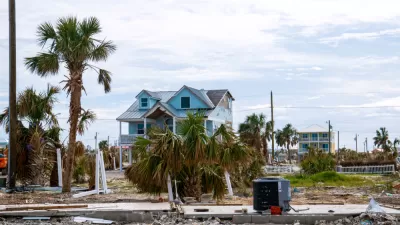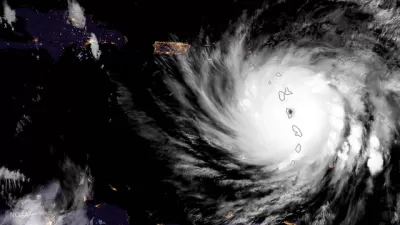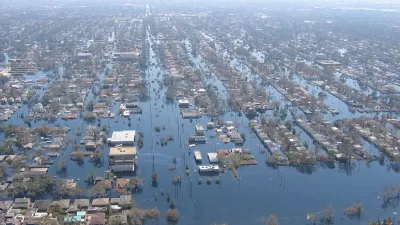As we brace for the second half of the 2024 hurricane season, we need to take serious action to help rural communities recover and build greater resilience against hurricanes.

We have reached the Atlantic hurricane season’s halfway point. With Tropical Storm Francine set to make landfall as a hurricane later today, the most active weeks yet ahead, and Houston still recovering from Hurricane Beryl’s bruising early-July impacts, cities across the Gulf Coast, East Coast, and the Caribbean are on high alert. Major coastal metro areas and their residents hope any remaining storms steer far away from their densely settled neighborhoods.
But sometimes a hurricane missing a major city means it hits less populated communities. Well-meaning city officials or meteorologists tend to express relief: “[t]he good thing is not many people live [there] . . . .We kind of dodged a bullet.” However, the consequences for rural communities are often dire for residents and destabilizing for the surrounding state and region. It’s crucial to recognize that there are profound human and economic tolls, even when a storm veers away from high-rise hotels and condos and instead topples pine forests, rolls mobile homes, and crushes farm buildings and equipment.
Inland rural communities get short shrift when hurricanes come to town
The reality is that, on balance, we pay less attention to rural disaster impacts. When much of Houston and Harris County’s power was restored after Hurricane Beryl, 40,000 customers in East Texas — 80 percent of whom resided in rural counties — remained without power for several more days. The capacity of the fragile electrical grid in Texas had already been stretched prior to Beryl’s arrival by a prolonged heat wave. And while Beryl's heavy rains and 80-plus mile per hour winds were concentrated around the Houston metro areas, the hurricane’s effects were felt across the country, from the rural Texas farming communities all the way to Vermont's Green Mountains. Some East Texas farmers couldn't recall such a strong tropical storm hitting when so much of their corn, sorghum, and cotton crops were still in the fields. Many farmers were left worried that a potentially strong summer and fall harvest could be diminished significantly.
The focus on disaster impacts on cities and urban areas is not new. Consider Hurricane Michael’s impact in 2018. That storm entered rural southwest Georgia — about 80 miles from the Florida coast — as the state’s first Category 3 Hurricane since the 1890s. Along its destructive path, the storm buzz-sawed Florida’s forest products industry and inflicted a $2.5 billion loss on Georgia’s agricultural sector, the state’s biggest industry. Press coverage of the storm receded quickly, and charitable donations for affected populations were a fraction of those received for disasters that struck more populated areas.
More recent major hurricanes suggest that Hurricane Michael’s sustained destructive power was not a fluke. Rural communities in the U.S. are potentially within the crosshairs of major hurricane almost 100 miles inland. The major storms that have followed Michael, including Ida (2021), Ian (2022), and Idalia (2023) may be signs of things to come. A 2020 article in Nature Communications suggests that tropical cyclones like Hurricane Michael, fueled by unusually warm ocean waters, are rapidly intensifying until landfall. Such storm intensification increases the chance that catastrophic wind speeds will press beyond densely populated coastal areas and well into our inland rural communities.
The bad news is that these inland rural communities are largely unprepared to rebound from a hurricane.
Rural homes are often older, and a greater proportion may be in disrepair and noncompliant with newer and more rigorous building code requirements. Rural areas also support agricultural, forest products, ecotourism, and sporting industries that are highly sensitive to weather-related hazards. In addition, rural communities tend to have a higher share of older populations and higher chronic disease prevalence than urban centers. Exacerbation of chronic diseases and the disruption of healthcare systems are noted health impacts associated with hurricane exposures. To make matters worse, new research suggests that rural communities have proportionately fewer hospital beds to receive and treat residents injured in major disaster events. Perhaps the greatest challenge facing rural communities and small towns is limited budget and staffing resources to support disaster response, recovery, and mitigation initiatives.
Real talk: Damage to rural communities hurts us all
It is imperative to focus some attention on rural communities, their disaster resilience, and sustainable futures. Home to roughly one in five Americans, rural areas are critical to the farming, forest products, ranching, and related industries that put food on our tables and supply cardboard for our Amazon delivery boxes. These rural communities are stewards of wetlands and rivers that pump life into coastal estuaries critical to aquatic life and our seafood industry. Rural wildlands are home to diverse flora and fauna, including endangered and protected species. Those who take these valuable and sometimes pristine resources for granted need to think again. In late April 2024, Florida’s Department of Environmental Protection signaled its intent to approve exploratory oil drilling on forestlands splintered by Hurricane Michael’s catastrophic winds. In approving the application to drill, the local county commission hoped the new wells “could bring badly needed revenue to the county, which saw its main industry, timber, wiped out by Hurricane Michael.” That is, major rural disasters have the power to reshape rural economies and to do so in ways that are unsustainable and could cause irreversible environmental harms.
What can we do to make rural communities more resilient?
NOAA predicted the 2024 Atlantic hurricane season would be even more active than normal. Whether or not that prediction turns out to be accurate over the next 11 weeks, there remains an urgent need to assist rural communities in ensuring a more sustainable future. Several options and opportunities should be considered:
- To start: Ensure rural communities have the resources to leverage current federal initiatives for improving rural infrastructure and expanding access to technical assistance.
- Plan, revise, repeat: Many rural communities are ‘flying blind’ in chaotic post-disaster environments. Federal, state, and philanthropic partners must invest money and technical assistance to ensure rural local governments create and adopt more robust hazard mitigation plans and pre-event disaster recovery and redevelopment plans.
- Nurture healthier housing ecosystems: It frequently takes years to repair housing stock following a disaster, particularly for low- and moderate-income families. To lay the foundation for a quicker and more equitable community recovery, rural communities must augment their capacity to manage code enforcement and housing rehabilitation programs. Partnerships with nonprofit, faith-based, or philanthropic entities can help rural communities establish temporary housing and permanent affordable housing options.
- Strategically deploy state institutions and resources: Recovery delayed is recovery denied. Political gridlock and regulatory requirements mean it can take years for federal long-term recovery aid to arrive. State-funded loans and grants can reach affected constituencies more quickly. Following Hurricane Michael, the state of Georgia tapped its agricultural lending authority to deploy more than $55 million in loans to Georgia farmers within three months. Federal block grants took about 17 months to arrive.
- “Never let a crisis go to waste”: Hurricane Michael and more recent catastrophic storms remain fresh in the minds of communities across the Gulf South and Southeast Atlantic coasts. Now is the time to incentivize local governments to document and audit their pre-storm infrastructure (i.e., road, water, wastewater, stormwater, and other utility systems), to maximize FEMA reimbursement for repairs. This is also the time to encourage businesses to create and update business continuity plans and to reengage farmers around federal programs that advance climate resilient agricultural and forestry practices.
There is a saying that “all recoveries are local.” Our rural communities must be prepared for hurricanes as well as other hazards. To leave the fate of rural communities, small cities, towns, and counties to chance risks economic and environmental peril. It also ensures that the most vulnerable members of our rural communities, including the elderly, migrant farmworkers, and low- and moderate-income individuals and families, will encounter even greater obstacles than they did before the storm. These are risks we as a nation can no longer afford to take.
This piece is co-authored by natural hazards researchers at Georgia State University, including John Travis Marshall, associate professor of law, Risa Palm, professor of urban studies, geography, and science communication; Ann-Margaret Esnard, professor of public management and policy, Christine Stauber, professor of public health; Natasha Malmin, assistant professor of public health; and Karen Johnston, deputy director of the Center for the Comparative Study of Metropolitan Growth.

Alabama: Trump Terminates Settlements for Black Communities Harmed By Raw Sewage
Trump deemed the landmark civil rights agreement “illegal DEI and environmental justice policy.”

Planetizen Federal Action Tracker
A weekly monitor of how Trump’s orders and actions are impacting planners and planning in America.

The 120 Year Old Tiny Home Villages That Sheltered San Francisco’s Earthquake Refugees
More than a century ago, San Francisco mobilized to house thousands of residents displaced by the 1906 earthquake. Could their strategy offer a model for the present?

LA’s Tree Emergency Goes Beyond Vandalism
After a vandal destroyed dozens of downtown LA trees, Mayor Karen Bass vowed to replace them. Days later, she slashed the city’s tree budget.

Sacramento Leads Nation With Bus-Mounted Bike Lane Enforcement Cameras
The city is the first to use its bus-mounted traffic enforcement system to cite drivers who park or drive in bike lanes.

Seattle Voters Approve Social Housing Referendum
Voters approved a corporate tax to fund the city’s housing authority despite an opposition campaign funded by Amazon and Microsoft.
Urban Design for Planners 1: Software Tools
This six-course series explores essential urban design concepts using open source software and equips planners with the tools they need to participate fully in the urban design process.
Planning for Universal Design
Learn the tools for implementing Universal Design in planning regulations.
Ada County Highway District
Clanton & Associates, Inc.
Jessamine County Fiscal Court
Institute for Housing and Urban Development Studies (IHS)
City of Grandview
Harvard GSD Executive Education
Toledo-Lucas County Plan Commissions
Salt Lake City
NYU Wagner Graduate School of Public Service





























